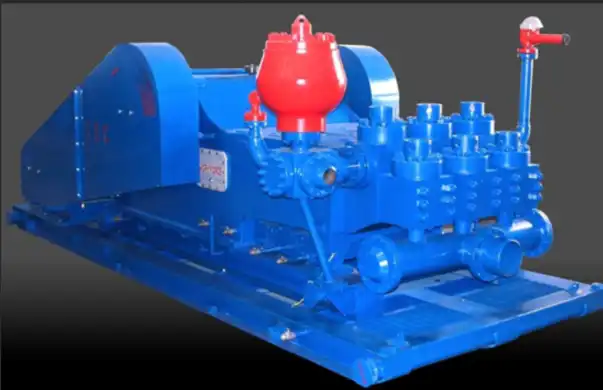Understanding mud pump displacement formulas
To accurately calculate the displacement of a mud pump, it's essential to understand the underlying formulas and their components. Let's break down the key elements and equations used in determining mud pump displacement.
Basic displacement formula
The fundamental formula for calculating the theoretical displacement of a mud pump is:
Displacement = π × (liner diameter/2)² × stroke length × number of cylinders
This equation provides the volume of fluid moved per pump revolution, typically expressed in gallons per stroke or liters per revolution.
Pump output formula
To determine the actual output of a mud pump, we need to consider the pump's efficiency and operating speed:
Pump Output = Displacement × Pump Speed × Volumetric Efficiency
Volumetric efficiency accounts for factors like fluid slippage and mechanical losses, usually ranging from 85% to 95% for well-maintained pumps.
Stroke rate and flow rate calculations
The stroke rate of a mud pump is typically measured in strokes per minute (SPM). To calculate the flow rate, use the following formula:
Flow Rate = Displacement per Stroke × Stroke Rate × Volumetric Efficiency
This calculation provides the actual volume of fluid being pumped per unit of time, often expressed in gallons per minute (GPM) or liters per minute (LPM).
Factors affecting pump displacement efficiency
Several factors can impact the efficiency and overall displacement of a mud pump. Understanding these elements is crucial for maintaining optimal performance and making necessary adjustments.
Liner and piston condition
The condition of the liner and piston significantly affects pump efficiency. Wear and tear on these components can lead to increased fluid slippage and reduced volumetric efficiency. Regular inspection and maintenance of liners and pistons are essential for maintaining optimal displacement.
Fluid properties
The characteristics of the drilling fluid, such as viscosity and density, can impact pump efficiency. Higher viscosity fluids may result in increased friction and reduced flow rates, while lower viscosity fluids might lead to increased slippage past the pistons.
Operating pressure
The pressure at which the mud pump operates can affect its displacement efficiency. Higher operating pressures may lead to increased mechanical losses and reduced volumetric efficiency.
Valve performance
The condition and performance of the suction and discharge valves play a crucial role in maintaining pump efficiency. Worn or damaged valves can result in fluid backflow and reduced displacement.
Practical methods to adjust mud flow
Adjusting the mud flow from a mud pump is essential for maintaining optimal drilling conditions. Here are some practical methods to modify the displacement and flow rate of a mud pump.
Changing pump speed
One of the most straightforward methods to adjust mud flow is by altering the pump speed. Increasing the stroke rate will result in higher flow rates, while decreasing it will reduce the flow. This method allows for quick adjustments without the need for equipment changes.
Liner size modification
Changing the liner size is another effective way to adjust mud pump displacement. Larger liners will increase the volume of fluid moved per stroke, while smaller liners will decrease it. However, this method requires downtime for equipment changes and should be planned accordingly.
Utilizing a duplex pump system
Implementing a duplex pump system allows for more flexible flow rate control. By using two pumps in parallel, operators can fine-tune the overall flow rate by adjusting the speed or engagement of individual pumps.
Pressure relief valve adjustment
Fine-tuning the pressure relief valve settings can help optimize mud flow and prevent over-pressurization. This adjustment allows for better control of the pump's discharge pressure and can help maintain consistent flow rates.
Conclusion
Understanding how to calculate and adjust the displacement of a mud pump is crucial for efficient drilling operations. By mastering the formulas and considering the various factors affecting pump efficiency, operators can optimize their mud circulation systems for improved performance. Regular maintenance, careful monitoring of operating conditions, and the ability to make timely adjustments are key to maintaining optimal mud pump displacement. As technology continues to advance, mud pump suppliers like CM Energy are developing innovative solutions to enhance pump efficiency and control. By staying informed about the latest advancements and best practices in mud pump technology, drilling operators can ensure they are maximizing the potential of their equipment and achieving the best possible results in their operations.
FAQ
1. What is the typical displacement range for modern mud pumps?
Modern mud pumps typically have displacement ranges from 300 to 2,500 gallons per minute (GPM), depending on the pump size and configuration. High-performance pumps from leading manufacturers like TSC can achieve even higher displacements for specialized applications.
2. How often should mud pump displacement be recalculated?
It's recommended to recalculate mud pump displacement regularly, especially after any maintenance or component replacements. A good practice is to perform calculations at least once per drilling operation or every 1,000 operating hours, whichever comes first.
3. Can mud pump displacement be adjusted while drilling is in progress?
Yes, mud pump displacement can be adjusted during drilling by changing the pump speed. However, major adjustments like liner size changes typically require a pause in operations. Always consult your pump manufacturer's guidelines for safe adjustment procedures.
Optimize Your Drilling Operations with CM Energy's Advanced Mud Pumps
Ready to elevate your drilling efficiency with precise mud pump displacement control? CM Energy's TSC brand offers cutting-edge mud pump solutions designed for optimal performance and reliability. Our advanced WF Series Mud Pumps feature compact designs, high efficiency, and customizable options to meet your specific drilling requirements. Experience the difference that industry-leading technology and expert support can make in your operations. Contact our team today at info.cn@cm-energy.com to discover how our mud pump solutions can transform your drilling projects and boost your productivity.
References
- Smith, J. A. (2023). Advanced Mud Pump Technology in Modern Drilling Operations. Journal of Petroleum Engineering, 45(3), 287-301.
- Johnson, R. B., & Williams, T. C. (2022). Optimizing Mud Pump Displacement: A Comprehensive Guide. Drilling Contractor's Handbook (5th ed.). Houston: Gulf Publishing Company.
- Chen, L., et al. (2024). Factors Affecting Mud Pump Efficiency in High-Pressure Drilling Environments. SPE Drilling & Completion, 39(1), 62-75.
- Thompson, E. M. (2023). Innovative Approaches to Mud Pump Displacement Adjustment. Offshore Technology Conference Proceedings, OTC-25789-MS.
- Miller, K. S., & Davis, R. A. (2022). The Impact of Fluid Properties on Mud Pump Performance. Journal of Fluid Mechanics and Hydraulics, 18(2), 145-159.
- Brown, H. L. (2024). Advancements in Mud Pump Design for Enhanced Displacement Control. Annual Review of Petroleum Technology, 7, 213-228.


